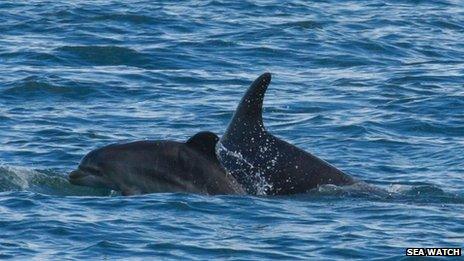Calving dolphins 'need more protection of Welsh coast,' Sea Watch says
- Published

Bottlenose dolphins calve in three areas off the coast of north and west Wales
Bottlenose dolphins calving off the coast of Wales need more protection, says a marine research charity which is about to survey the newborns of 2013.
The Sea Watch Foundation said the mammals have little added protection at conservation sites in Cardigan Bay and the Llyn Peninsula and none around Anglesey.
The calving begins in April but peaks in July and August.
The charity has studied the bottlenose dolphin populations for six years.
Its results presented at a conference in Portugal this month showed that calving dolphins had a smaller home range than others.
"Safe calving grounds are vitally important for cetaceans and should play an important role in conservation management plans," said the study's authors, Sea Watch's monitoring officer Daphna Feingold, and research director Dr Peter Evans.
They added: "This research has identified important locations used by nursing bottlenose dolphins, which should now be granted additional protection from potential disturbance to help ensure the population remains stable and preferably increases."
The charity said the three areas identified - Cardigan Bay, Llyn Peninsula and one off the north-east coast of Anglesey - are home to the largest semi-resident populations of bottlenose dolphins in the UK.
Ms Feingold said: "In the last few years, we have had some evidence that dolphins are using Cardigan Bay Special Area of Conservation to a lesser extent, and that may be due to disturbance since boating has increased and has been shown to have a negative effect on the animals."
In May 2012, Cardigan Bay Marine Wildlife Centre (CBMWC) identified 300 individual dolphins which use the bay.
- Published14 September 2011
- Published11 May 2012
- Published9 August 2011